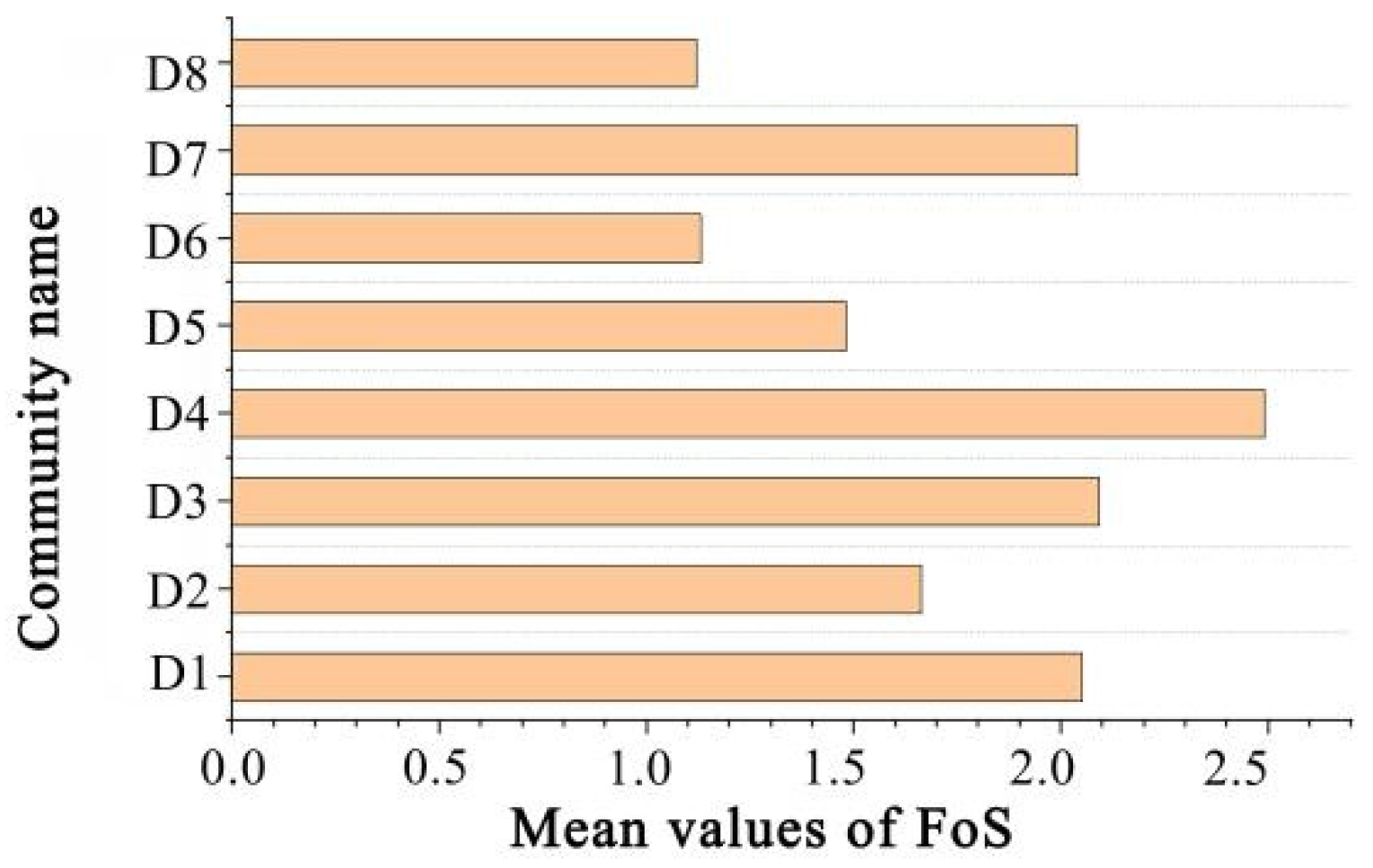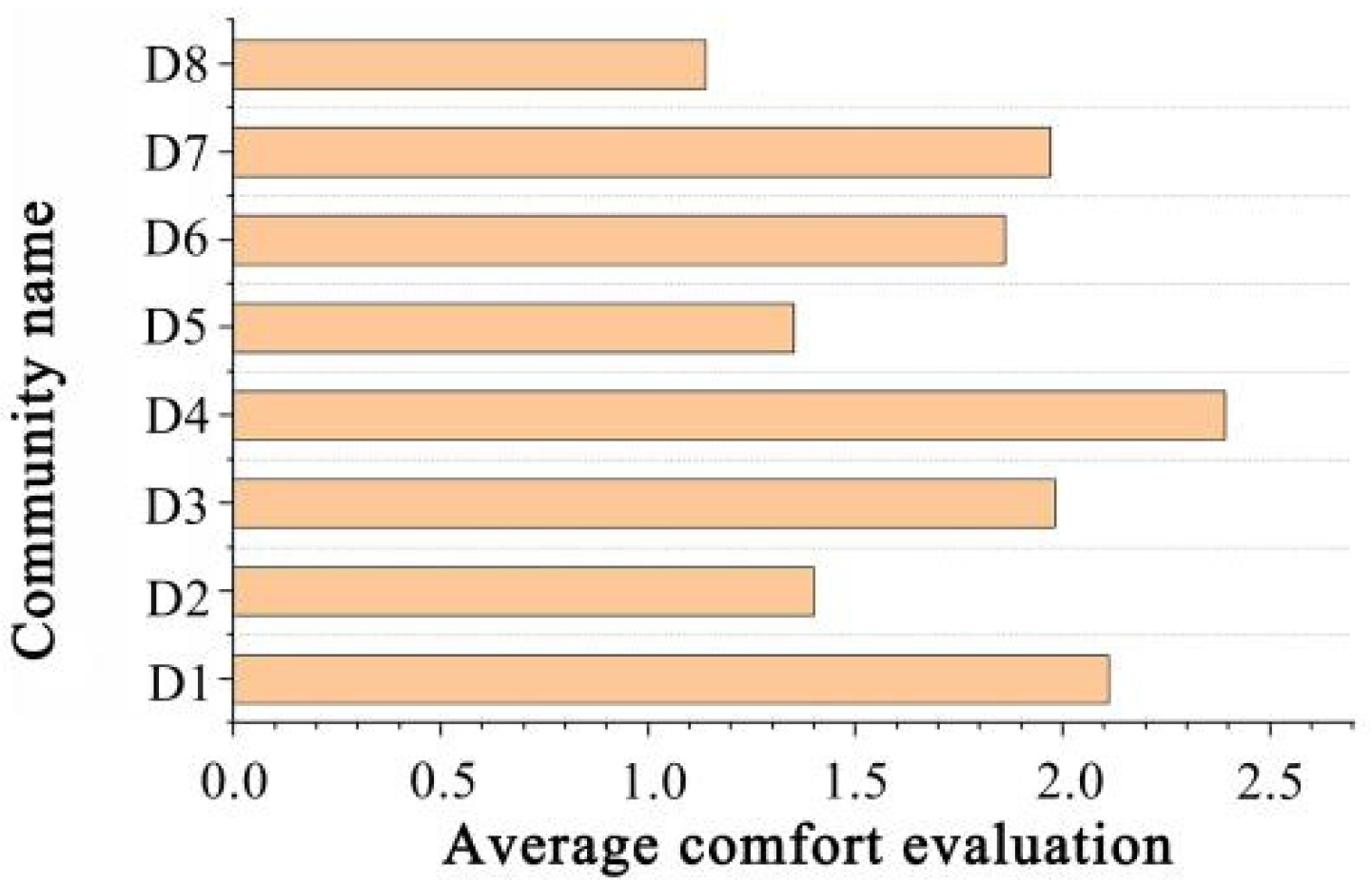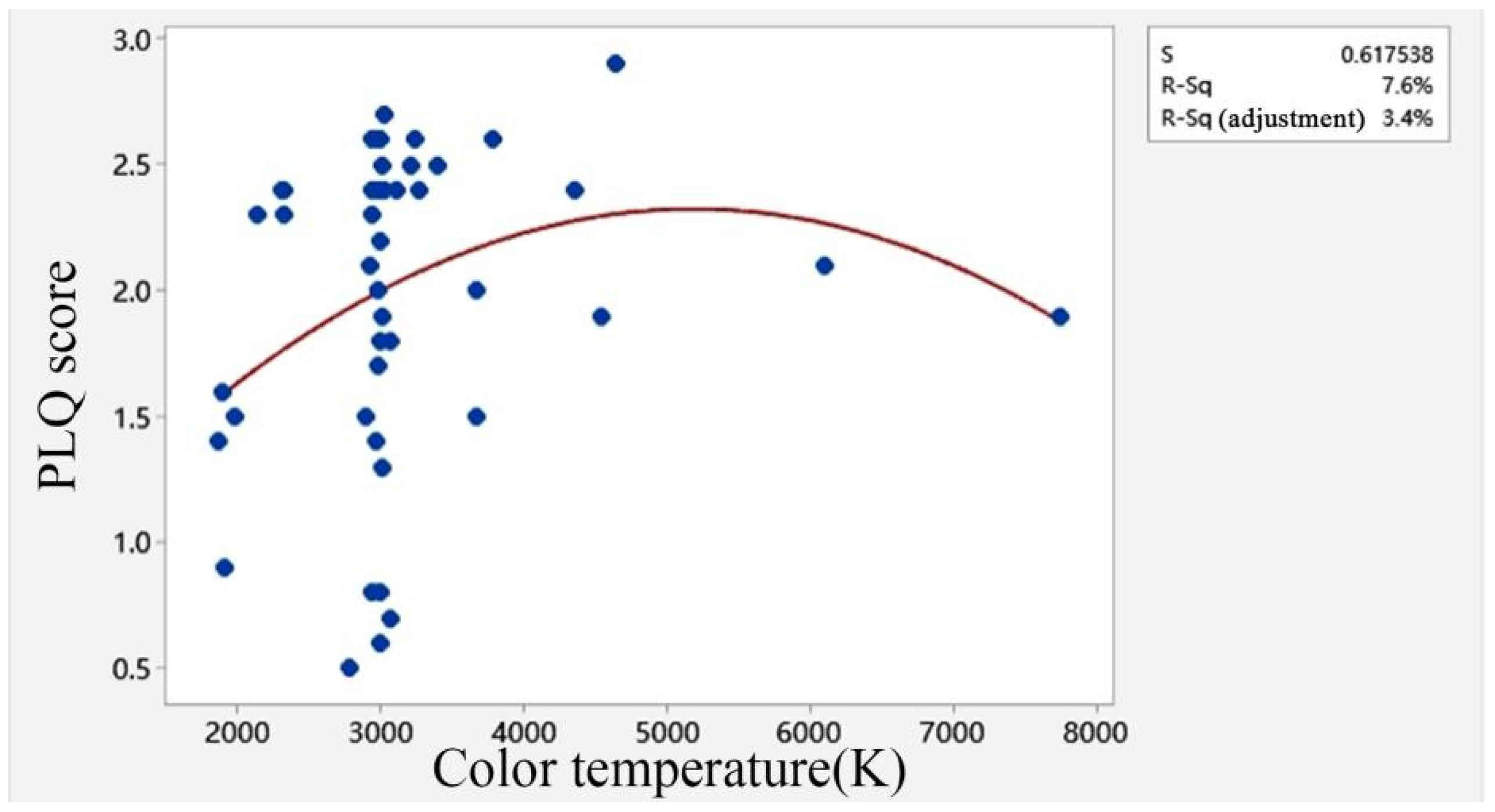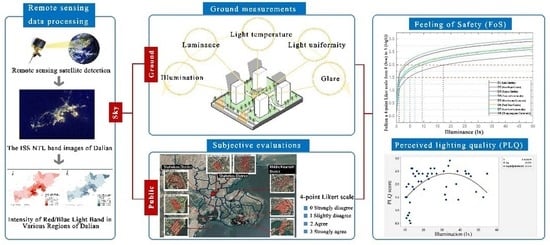3.1. Analysis of FoS
PSL features comprise several attributes: illumination, color temperature, uniformity, and glare [
29], each of which might affect FoS, energy consumption, and human health. However, there is a lack of empirical models associating lighting attributes with FoS that consider various contextual factors.
This study attempts to fill this knowledge gap and develop multiple PSL–FoS models, which connect lighting, color temperature, uniformity, and glare values with FoS, and control for personal, location, and environmental factors. Using such models might help to improve the satisfaction and well-being of urban residents while reducing health and ecological risks and improving energy efficiency.
- (1)
Factors affecting FoS.
Table 3 shows the main research variables and their coding. The Akaike information criterion (AIC for short) shows whether adding a particular parameter improves the fitting degree of the model, but also introduces a penalty term to minimize the model parameters, which helps to reduce the possibility of over-fitting [
30]. In this study, the AIC increment test was used to determine the influence weight of each research variable on FoS, while regression analysis, performed in the SPSS software, was used to identify the impact of each factor on FoS. In
Figure 19, we estimate the relative contribution of each factor to FoS. The AIC and AIC increment can be obtained according to the sum of squares of the residuals. The larger the AIC increment, the greater the relative contribution of this factor to FoS.
- (2)
Comparison of security evaluation results among different groups of people
① Age
The two independent group difference test includes independent sample
t-test and Mann–Whitney U-test. Independent sample
t-test is used to compare whether there is a difference in the mean value of a variable between two independent groups. It is a kind of
t-test (also known as Student’s
t-test). An independent samples
t-test was used to compare the mean values of the variables between two independent age groups. The average FoS of participants aged 18–40 yo was 1.95 (SD = 0.904), and that of participants aged 41–61 was 1.61 (SD = 0.908). Independent
t-tests (
Table 4) showed that there was a significant difference between younger respondents and older respondents (
p < 0.005,
t = 6.099).
② Gender
In an independent sample
t-test (
Table 5), the average perceived safety of men was 2.09 (SD = 0.827) and that of women was 1.64 (SD = 0.955). The homogeneity test of variance showed that the variance of the two groups was not homogeneous (F = 54.011,
p = 0.000 < 0.05) and that the variance corrected
t-test should be used. The adjusted
t-test result was t(DF) = −11.230 (1778.285),
p = 0.000 (<0.05), which indicates that the FoS score of males’ safety perception evaluations was 2.09 ± 0.82 and the females’ FoS score was 1.64 ± 0.95. The difference was statistically significant at a 0.01 level, and the score of males was significantly higher than that of females, thus indicating that, on average, men feel safer than women in the same urban settings.
- (3)
Correlation between illuminance values and safety evaluation values
① Mann–Whitney U-test
The Mann–Whitney U-test is a kind of nonparametric test which does not require the overall normal distribution [
31]. Therefore, it is generally used when the data do not meet the normality requirements of a
t-test. In order to evaluate whether there was a correlation between the value of perceived safety and illumination, a nonparametric Mann–Whitney U-test was conducted. The average and median of illumination levels were decomposed into low illumination and high illumination, and the safety evaluations of different illumination conditions were compared. The results showed that there was a significant difference in the level of perceived safety (
p < 0.01), and the safety evaluation scores of the places with sufficient light were much higher than those of the places with insufficient light.
② Bivariate OLS regression
Ordinary least squares (OLS) method is the most fundamental form of regression analysis. It requires the least model conditions, that is, to minimize the square sum of the distance between all observations on the scatter diagram and the regression line. Binary regression analysis was conducted on the original value and the log-transformed values of the illuminance data. The results are shown in
Table 1. Models 1a, 1b, and 1c represent the regression models of the original value of illuminance in the horizontal, vertical, and vertical panoramic directions, respectively, while Models 1d, 1e, and 1f represent the regression models of the log-transformed values of illuminance in horizontal, vertical, and vertical panoramic directions, respectively.
It can be seen from
Table 6 that, among the three lighting measurement models based on the horizontal, vertical, and vertical panoramic directions, the model that used the horizontal measurements provided the best result (R
2 = 0.362). Logarithmic transformation of the original lighting values further improved the model fit as indicated by R
2 increase from 0.362 to 0.562. The improvement in this model shows that the association between FoS and illumination levels is actually nonlinear.
Figure 20 and
Figure 21 show the relationship between FoS and the logarithm of illuminance and the original value of illuminance, respectively. It can be seen from
Figure 21 that with an increase in horizontal illuminance, the overall feeling of safety also increases, but after reaching the value of 10 lx, the rate of FoS response becomes slower.
- (4)
Correlations of the comprehensive effects of environmental factors and illuminance values with FoS evaluations
Illuminance values are often affected by environmental factors, especially vegetation density and traffic density [
32,
33,
34]. Vegetation can obscure streetlights, resulting in a reduction in the lighting level and uneven distribution of illumination, while more vehicles improve the overall brightness of the residential road lighting. In addition, due to their different environmental and lighting conditions, each residential area under study can be regarded as an exogenous environmental variable. Therefore, in order to reveal the true relationship between the safety level (dependent variable) and the light level measured by the instruments, potential confounding by environmental factors (vegetation density and traffic density), needs to be accounted for using a multiple regression analysis method. The results of such analysis are shown in
Table 7. Model 2 only takes the horizontal ground lighting as the explanatory variable, and Model 3 adds the vegetation density and traffic intensity. Model 4 adds the residential community into the model. The variables of residential areas are classified variables and needed to be transformed into dummy variables. By building a regression model, each dummy variable obtained an estimated regression coefficient, which makes the regression results easier to explain.
According to the regression results reported in
Table 7, graphs of confounder-adjusted associations between FoS and illuminance were drawn. To generate these graphs, the values of all variables (except for illumination) were set to their average levels, and the lighting levels were allowed to vary from 0 to 50 lx (
Figure 22).
The graphs show that higher illuminance levels do not necessarily mean the same increase in perceived security levels. The perceived safety score range is 0–3 and the median value is 1.5; safety is acceptable if the evaluated value is higher than 1.5 and safety is better if the evaluated value is higher than 2.0. As it is also shown in
Figure 22, to achieve the safety level of 1.5, the corresponding illumination value needs to reach 1.0–5.0 lx, depending on the neighborhood. Concurrently, for the safety level to reach 2.0 (on a 3-point scale), the corresponding illuminance value needs to be in the 2.7–17 lx range. As
Figure 22 further shows, after the illuminance reaches about 17 lx, the rate of change in FoS becomes slower and slower in line with a further increase in illuminance. In other words, after the illumination level of 5–17 lx, the perceived safety increases only marginally.
- (5)
Correlations between illumination uniformity and FoS
The uniformity of lighting can be divided into three levels: ununiform lighting, slightly discontinuous lighting, and uniform lighting. The uniformity values were scored and collected by the research team during the field investigation, in which ununiform lighting was given the value of 0, discontinuous lighting was given the value of 1, and uniform lighting was set to 2.
Independent sample t-test is suitable for analyzing the score difference between two independent groups on a variable. For multiple independent groups, only pairwise t-test can be carried out, but this would increase the error. One way analysis of variance (one way ANOVA) assumes that there is no difference in the mean of multiple groups, and analyzes multiple groups at the same time, which avoids the dilemma of t-test and is an extension of the t-test. One-way ANOVA was used to analyze the FoS scores. The results of the ANOVA (F = 9.091, p = 0.000 < 0.05) showed that there was homogeneity of variance among the different groups, which indicated that there were considerable differences in the FoS levels between the different uniformity groups.
Moreover, according to the post hoc analysis, there was no significant difference between sparse illumination and uniform illumination, but there were significant differences among discontinuous illumination, sparse illumination, and uniform illumination. The differences in the sense of security are shown in
Figure 23. As
Figure 23 shows, observers evaluate scenes with uniform illumination as more safe than scenes with discontinuous illumination.
- (6)
Correlation between spectral characteristics and FoS
In the first step, Kendall’s test was used to determine whether there was a significant correlation between light color temperature and FoS. According to this test, there is a direct and significant relationship between the two variables.
In order to explore the differences in people’s perceptions of yellow light and white light, a t-test was conducted. The average perceived security of white light was 1.54 (SD = 0.707) and that of yellow light was 1.96 (SD = 0.617). The homogeneity of variance test showed that the variance of the two groups was inhomogeneous (F = 2.620, p = 0.108 > 0.05), indicating that the variance of the white light group was not equal to that of the yellow light group. After the variance adjusted test was run, the results indicated that the FoS score of white light was 1.54 ± 0.71 and yellow light’s FoS score was 1.96 0 ± 0.62 The difference (−0.42) was statistically significant (t = −3.654 (n = 158), p < 0.05). In other words, the FoS score of yellow light was significantly higher than that of white light, implying that people feel significantly safer under yellow light than under white light.
Previous studies have shown that the use of white light is more beneficial for enhancing color rendering, which can have a positive impact on crime and perceived safety. As this study was carried out in winter, the warm light may make people feel warmer, safer, and more comfortable. In future research, we could further verify whether different seasons and temperatures affect pedestrians’ safety perceptions of color temperature.
3.2. Analysis of PLQ
(1) Influence of lighting attributes on PLQ
The analysis method for PLQ is different from that of FoS [
35]. In this section, the analysis of PLQ association with illumination attributes was run separately for low illumination (0–10 lx) and high illumination (>10 lx). The comfort levels of two measurement points with different illuminance levels were analyzed.
Spearman correlation analysis is a common correlation analysis method, which uses monotone equation to evaluate the correlation of two variables. Spearman correlation was used to examine the significant relationships between the PLQ and lighting attributes. It can be seen in
Table 8 that when illuminance is ≤10 lx, the correlation coefficient between PLQ and illuminance is r = 0.343 (
p < 0.01), indicating that there is a strong positive correlation between PLQ and illuminance. Concurrently, the correlation coefficient between PLQ and glare is r = −0.091 (
p > 0.05), indicating that there is no significant correlation between perceived visual comfort and glare. The correlation coefficient between PLQ and color temperature is r = −0.095 (
p > 0.05), also indicating no significant association. The correlation coefficient between PLQ and uniformity is r = 0.285 (
p < 0.01), indicating that there is a significant positive association. Therefore, when illuminance is ≤10 lx, the main lighting factors affecting PLQ are
illuminance and
uniformity.
It can be seen from
Table 8 that when illuminance is greater than 10 lx, the correlation coefficient between PLQ and illuminance is r = 0.326 (
p < 0.05), indicating that there is a strong positive correlation between visual comfort and illuminance. The correlation coefficient between PLQ and glare is r = −0.294 (
p > 0.05), indicating that there is a significant negative correlation between comfort and glare. The correlation coefficient between PLQ and color temperature is r = −0.178 (
p < 0.01), indicating that there is a significant negative correlation between comfort and color temperature. The correlation coefficient between PLQ and uniformity is r = 0.198 (
p < 0.05), indicating that there is a significant positive correlation between comfort and uniformity. Therefore, when illuminance is >10 lx, the main lighting factors affecting PLQ are illuminance, glare, color temperature, and uniformity.
(2) PLQ in low illumination levels
Spearman’s correlation test showed that the perceived brightness and uniformity of the street environment were the main determinants of PLQ is the lighting level was less than 10 lx. In this analysis, PLQ score was the dependent variable, illumination was the independent variable, and uniformity was the classification variable. Due to the positive correlation between PLQ and illuminance and uniformity, when the illumination is less than or equal to 10 lx, the PLQ score increases with an increase in illumination and the level of uniformity.
(3) PLQ in high illuminance levels
When the illumination level is lower than 10 lx, the light spectrum and illuminance of the light source have little impact on the PLQ. When the lighting level is higher than 10 lx, the spectrum and illuminance of the light source have a more important impact on the PLQ. The reason is that the sense of security is satisfied after the illuminance is improved, and the residents’ concerns will be biased towards the psychological feelings created by the color temperature and illuminance of lighting. The regression analysis between PLQ and horizontal lighting and other related factors is carried out to obtain the following regression equation:
where
ILji—Vector value of illuminance measurement (point horizontal, point vertical and vertical panorama) at point
i;
GRi—Glare value of point
i;
CTi—Color temperature of point
i; and
εi—Random error term.
Spearman correlation test shows that when the illumination level is lower than 10 lx, the perceived brightness and uniformity of street environment become the main determinants of PLQ. The PLQ score is the dependent variable, the illumination value is the independent variable, and the uniformity grade is the classification variable. Multiple regression analysis was performed in SPSS, and the results are shown in
Table 9.
Multiple regression analysis in SPSS showed that if the illuminance value is lower than 35 lx, PLQ would increase with an increase in illuminance (
Figure 24). However, when the illuminance value exceeds 35 lx, PLQ decreases, which indicates that, for visual comfort, higher illuminance does not always mean better. Excessive illuminance of streetlights may cause discomfort, glare, and even affect visual function. Satisfactory levels of PLQ were higher at illuminance levels of 25–35 lx.
As a reminder, in the analysis of the factors influencing safety perceptions, it was found that there is no significant relationship between glare and perceived safety. The research results show that intense glare would have a strong impact on perceived safety, however, slight glare can produce unpleasant feelings.
It can be seen from
Figure 25 that when the color temperature is in the range of 4000–5500 K, the PLQ score is higher, indicating that people prefer cold white light, which probably because this color temperature range is closer to the natural light.
































